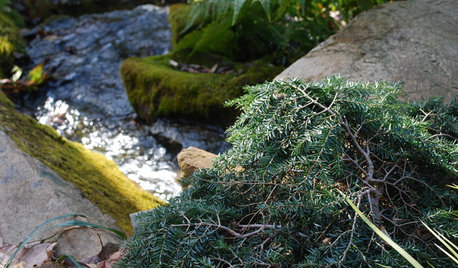Grafting Info
aspenacres
11 years ago
Related Stories

EDIBLE GARDENSHow to Grow 10 Favorite Fruit Trees at Home
Plant a mini orchard in fall, winter or early spring to enjoy fresh-off-the-tree fruit the following year
Full Story
GARDENING AND LANDSCAPINGCrazy for Fruit Trees
Whether a single citrus or a mini apple orchard, even the smallest landscape space can bear deliriously delicious fruit
Full Story
WINTER GARDENINGPruning Secrets for Exquisite Roses
Encourage gorgeous blooms year after year with this time-tested advice on how to prune your rosebush in winter for health and shape
Full Story
EDIBLE GARDENSHow to Add an Apple Tree to Your Edible Garden
Readily available, beautiful and fragrant, apple trees offer four-season interest along with crisp, juicy fruit
Full Story
GARDENING GUIDESGreat Design Plant: Tsuga Canadensis ‘Bennett’
Bennett Canadian hemlock thrives in shade and provides sculptural interest in eastern U.S. gardens
Full Story
TREES11 Japanese Maples for Breathtaking Color and Form
With such a wide range to choose from, there’s a beautiful Japanese maple to suit almost any setting
Full Story
GARDENING GUIDES6 Steps to Get a Garden Off to a Glowing Start
Grow a lush, balanced garden from an empty patch of yard or neglected landscape spot with these easy-to-follow guidelines
Full Story
BEFORE AND AFTERSSee 6 Yards Transformed by Losing Their Lawns
Wondering whether a turf lawn is the best use of your outdoor space? These homeowners did, and they found creative alternatives
Full Story
GARDENING GUIDESTree Care: Common Tree Diseases and What to Do About Them
Learn to recognize trees that may be affected by diseases or pests so you can quickly take action
Full Story
LANDSCAPE DESIGNPretty Trees for Patios, Paths and Other Tight Spots
Choose trees for their size, shape and rate of growth — or shape them to fit your space. Here's how to get started
Full StoryMore Discussions








famartin
akamainegrower
Related Professionals
Kenmore Landscape Architects & Landscape Designers · South Orange Landscape Architects & Landscape Designers · Mooresville Landscape Contractors · Centereach Landscape Contractors · Fort Myers Landscape Contractors · North Plainfield Landscape Contractors · North Ridgeville Landscape Contractors · Sammamish Landscape Contractors · Littleton Siding & Exteriors · Oak Park Siding & Exteriors · South Laurel Siding & Exteriors · Springfield Siding & Exteriors · Leander Decks, Patios & Outdoor Enclosures · Lewisville Decks, Patios & Outdoor Enclosures · Somerville Decks, Patios & Outdoor EnclosuresaspenacresOriginal Author
aspenacresOriginal Author
taxo_man
aspenacresOriginal Author
taxo_man
aspenacresOriginal Author
taxo_man
aspenacresOriginal Author
terrene
taxo_man
brandon7 TN_zone7
taxo_man
terrene
brandon7 TN_zone7
akamainegrower
gardener365
sam_md